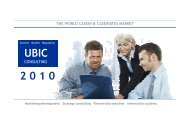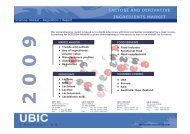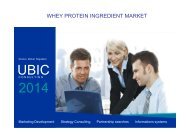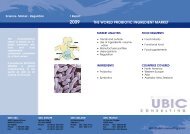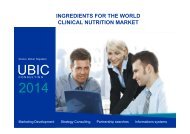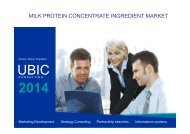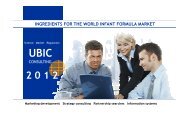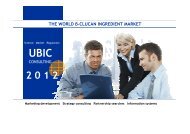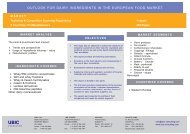PROTEIN HYDROLYSATE INGREDIENT MARKET - UBIC-Consulting
PROTEIN HYDROLYSATE INGREDIENT MARKET - UBIC-Consulting
PROTEIN HYDROLYSATE INGREDIENT MARKET - UBIC-Consulting
Create successful ePaper yourself
Turn your PDF publications into a flip-book with our unique Google optimized e-Paper software.
<strong>PROTEIN</strong> <strong>HYDROLYSATE</strong> <strong>INGREDIENT</strong> <strong>MARKET</strong><br />
Science Market Regulation<br />
<strong>UBIC</strong><br />
C O N S U L T I N G<br />
2014<br />
Marketing Development Strategy <strong>Consulting</strong> Partnership searches Informations systems
Technical & Competitive Scanning – Regulations – Manufacturers<br />
This comprehensive report is based on in-depth interviews with food companies completed by a desk review.<br />
It provides for DECISION MAKERS a global understanding of the sector as well as an outlook on its future.<br />
<strong>MARKET</strong> ANALYSIS<br />
New trends and perspectives<br />
Usage of ingredients: volume -value<br />
Production volumes by country<br />
Suppliers<br />
Dietetic, Medical and Sportsfood<br />
manufacturers company profiles<br />
FOOD SEGMENTS<br />
Infant formula<br />
Dietetic & Sport & Slimming Foods<br />
Clinical Nutrition<br />
COUNTRIES COVERED<br />
North America<br />
Western Europe<br />
<strong>INGREDIENT</strong>S COVERED<br />
Whey protein hydrolysate<br />
Casein hydrolysates
<strong>PROTEIN</strong> <strong>HYDROLYSATE</strong> <strong>INGREDIENT</strong> <strong>MARKET</strong><br />
O B J E C T I V E S<br />
M A R K E T<br />
Trends<br />
Industrial user’s<br />
expectations<br />
Prospective<br />
M A N U F A T U R E R S<br />
Food industry<br />
orientations<br />
Applications in food<br />
segments<br />
Consumption<br />
U S E R S<br />
New researches and<br />
new development<br />
DESCRIPTION<br />
Milk protein hydrolysates are a group of peptides<br />
derived from milk proteins. There are two sources<br />
of milk protein hydrolysates: whey protein<br />
hydrolysates and casein hydrolysates.<br />
NUTRITIONAL PROPERTIES<br />
Peptides may be absorbed slightly better and<br />
more quickly than amino acids or whole protein.<br />
This is due to the fact that di- and tripeptides can<br />
be directly absorbed from the gut by uptake<br />
systems that are independent of those used by<br />
amino acids.<br />
Moreover, recent studies have found that rats<br />
grow more rapidly when fed with isocaloric and<br />
isonitrogenous quantities of peptide diets as<br />
compared to intact protein and amino acids based<br />
diets.<br />
NUTRACEUTICAL PROPERTIES<br />
Both whey protein hydrolysates and casein<br />
hydrolysates have low antigenic properties.<br />
Symptoms<br />
Cow milk protein allergy (CMPA) is characterized<br />
by a wide range of symptoms and signs affecting<br />
the gastro-intestinal tract, the respiratory system<br />
and the skin. Symptoms include those commonly<br />
associated with immunoglobulin E (IgE)-<br />
associated reactions, and Non-IgE-associated,<br />
immunological mediated conditions.<br />
All proteins are potentially allergenic. Unmodified<br />
cow's milk itself contains more than 32 proteins<br />
of high allergic potential that may induce CMPA.<br />
The three most important are:<br />
-lactoglobulin<br />
caseins<br />
-lactalbumine<br />
18 kDa<br />
18 - 24 kDa<br />
14 kDa<br />
Those proteins are indeed more frequently allergenic<br />
than bovine serum albumin (68 kDa), lactoferrine,<br />
and gammaglobulines…<br />
SUMMARY OF INTERVIEWS:<br />
•Name of the Company<br />
•Level of competition and competitive products<br />
(level of hydrolysis and methods of<br />
measurement)<br />
•Volume of hydrolysates used<br />
• What do purchasers expect from new products<br />
•At a nutritional level?<br />
•At the functional level? (thermo stability, stability<br />
with a low pH, improved solubility and viscosity)<br />
•At the level of hydrolysis concentration?<br />
•Moderate Hydrolysates: DH 10 to DH 20<br />
•HA Hydrolysates (allergy prevention) :<br />
20
<strong>PROTEIN</strong> <strong>HYDROLYSATE</strong> <strong>INGREDIENT</strong> <strong>MARKET</strong><br />
O B J E C T I V E S<br />
<strong>MARKET</strong><br />
M A R K E T<br />
Trends<br />
Industrial user’s<br />
expectations<br />
Prospective<br />
M A N U F A T U R E R S<br />
Food industry<br />
orientations<br />
Applications in food<br />
segments<br />
Consumption<br />
U S E R S<br />
CLINICAL NUTRITION<br />
During the common process of nutrition,<br />
dietary proteins are presented to the<br />
immune system via the gut, followed by<br />
an immune unresponsiveness to the<br />
ingested nutrients. This vital phenomenon,<br />
called oral tolerance, is efficient for the<br />
large majority of people. If oral tolerance<br />
fails, food allergy occurs, requiring the<br />
strict avoidance of the incriminated food.<br />
Targeted food avoidance represents a<br />
hard task for adult patients with food<br />
allergy. For example, to strictly remove<br />
cow's milk from the diet of allergic infants<br />
might be even more difficult, especially if<br />
breastfeeding is not possible or desired.<br />
SPORTS FOOD<br />
Hydrolysates present, besides a faster digestibility, the<br />
advantage of maintaining a higher biological value of<br />
the proteins. This is particularly true for whey, which is<br />
also less concerned by the speed of digestibility since<br />
non hydrolysed proteins are already rapidly digested at<br />
the beginning of the duodenum.<br />
INFANT NUTRITION<br />
Protein allergy is more than a tolerance problem. It<br />
means that the infant's immune system has responded<br />
in an abnormal way to the protein in his/her diet. This<br />
can happen with both milk-based and soy-based<br />
formulas, and it tends to run in families. What happens<br />
is that the baby's immune system identifies the<br />
"whole" protein in his/her formula as foreign. His/her<br />
immune system responds much like it would to a virus<br />
— and manufactures antibodies in defence.<br />
Trends in<br />
use of<br />
hydrolysate<br />
s in Infant<br />
Formula<br />
New researches and<br />
new development
<strong>PROTEIN</strong> <strong>HYDROLYSATE</strong> <strong>INGREDIENT</strong> <strong>MARKET</strong><br />
O B J E C T I V E S<br />
WORLD HYDRLYSATE <strong>MARKET</strong> – 2012 – ACCESSIBLE <strong>MARKET</strong><br />
M A R K E T<br />
Trends<br />
Industrial user’s<br />
expectations<br />
Prospective<br />
Nutrition<br />
Segment<br />
Hypoallegenic<br />
Infant formula<br />
Clinical<br />
nutrition<br />
Nutrition Bars<br />
Finished<br />
products<br />
market<br />
volume<br />
In tons<br />
USA J EU Whey<br />
Hydrolys<br />
ate<br />
consump<br />
tion in<br />
tons<br />
Casein<br />
Market<br />
value in<br />
US$ mio<br />
M A N U F A T U R E R S<br />
Food industry<br />
orientations<br />
Applications in food<br />
segments<br />
Consumption<br />
U S E R S<br />
Body building 1 2,650 26<br />
Nutraceuticals 150 2<br />
Others<br />
3,000 21<br />
(Microbiologic<br />
al culture<br />
media)<br />
Total 12,400 -<br />
14,400<br />
2,000 164<br />
New researches and<br />
new development
<strong>PROTEIN</strong> <strong>HYDROLYSATE</strong> <strong>INGREDIENT</strong> <strong>MARKET</strong><br />
O B J E C T I V E S<br />
M A R K E T<br />
Trends<br />
Industrial user’s<br />
expectations<br />
Production<br />
by country<br />
and<br />
ingredient<br />
category<br />
Prospective<br />
M A N U F A T U R E R S<br />
Food industry<br />
orientations<br />
Applications in food<br />
segments<br />
Suppliers<br />
profiles and<br />
market<br />
shapes<br />
Table of<br />
Contents<br />
Milk and Whey<br />
Protein<br />
Hydrolysate<br />
consumption<br />
by country and<br />
food segment<br />
Consumption<br />
U S E R S<br />
New researches and<br />
new development<br />
Food company<br />
profiles<br />
detailing their<br />
expectations<br />
towards product<br />
and service
<strong>PROTEIN</strong> <strong>HYDROLYSATE</strong> <strong>INGREDIENT</strong> <strong>MARKET</strong><br />
O B J E C T I V E S<br />
M A R K E T<br />
Trends<br />
Industrial user’s<br />
expectations<br />
Prospective<br />
M A N U F A T U R E R S<br />
Food industry<br />
orientations<br />
Applications in food<br />
segments<br />
Consumption<br />
U S E R S<br />
New researches and<br />
new development<br />
CLINICAL<br />
NUTRITON<br />
Detailed<br />
Interview<br />
Fresenius<br />
Kabi<br />
Novartis<br />
General<br />
Interview<br />
Mead<br />
Johnson<br />
Abbott<br />
Nutrition<br />
INFANT NUTRITON<br />
Detailed<br />
Interview<br />
Mead<br />
Johnson<br />
Friesland<br />
Humana<br />
Numico<br />
Bledina<br />
Sodiac<br />
Nestle<br />
Valio<br />
Meiji<br />
General<br />
Interview<br />
Abbott<br />
Nutrition<br />
Hippwerke<br />
Morinaga<br />
Hochdorf<br />
Farley’s<br />
Lyempf<br />
Puleva<br />
Wyeth<br />
Star<br />
SPORTS NUTRITON<br />
Detailed<br />
Interview<br />
Joe<br />
Weider<br />
MLC<br />
Inkc<br />
General<br />
Interview<br />
Lab Equilibre att<br />
Nutrition & sante<br />
Robert schwarz<br />
Pharma Sweet<br />
Biodynamics<br />
Best Protein<br />
Nutrisport<br />
Gefa lab<br />
Eurosup<br />
Hedelab<br />
Fenioux<br />
Nutrinov<br />
Sponser<br />
Vitaphar<br />
Twinlab<br />
Insudiet<br />
GSN<br />
Reeb
TABLE OF CONTENTS<br />
<strong>PROTEIN</strong> <strong>HYDROLYSATE</strong> <strong>INGREDIENT</strong> <strong>MARKET</strong>
TABLE OF CONTENTS<br />
<strong>PROTEIN</strong> <strong>HYDROLYSATE</strong> <strong>INGREDIENT</strong> <strong>MARKET</strong>
<strong>PROTEIN</strong> <strong>HYDROLYSATE</strong> <strong>INGREDIENT</strong> <strong>MARKET</strong><br />
LIST OF TABLES<br />
List of Tables<br />
TABLE 1 : WORLD <strong>HYDROLYSATE</strong> <strong>MARKET</strong> – 2012 ACCESSIBLE <strong>MARKET</strong> .....................................................................................12<br />
TABLE 2: WHOLESALE PRICE IN US$ ....................................................................................................................................13<br />
TABLE 3: USE OF <strong>HYDROLYSATE</strong>S IN ENTERAL NUTRITION ..........................................................................................................15<br />
TABLE 4: SUMMARY OF INTERVIEWS – TECHNICAL PROPERTIES FOR MAIN MANUFACTURERS IN CLINICAL NUTRITION ............................16<br />
TABLE 5: WORLD CLINICAL & ENTERAL NUTRITION COMPANIES – USE OF <strong>HYDROLYSATE</strong>S ..............................................................17<br />
TABLE 6: HA INFANT FORMULA <strong>MARKET</strong>S -2012 - IN TONS .....................................................................................................18<br />
TABLE 7: WORLD BABYMILK CONSUMPTION OF <strong>HYDROLYSATE</strong>S IN TONS – 2012 ..........................................................................19<br />
TABLE 8: TRENDS IN USAGE OF MILK <strong>PROTEIN</strong> <strong>HYDROLYSATE</strong>S IN HYPOALLERGENIC FORMULAS .........................................................20<br />
TABLE 9: COMPANIES USING <strong>HYDROLYSATE</strong>S AND SUMMARY OF PRODUCT USAGE IN INFANT FORMULA .............................................21<br />
TABLE 10: COMPANIES USING <strong>HYDROLYSATE</strong>S IN THE SPORTS FOOD <strong>MARKET</strong> AND SUMMARY OF PRODUCT USAGE ...............................29<br />
TABLE 11: MAIN SUPPLIERS OF WHEY <strong>HYDROLYSATE</strong>S .............................................................................................................32<br />
TABLE 12: SYMPTOMS OF COW’S MILK ALLERGY .....................................................................................................................36<br />
TABLE 13: HYPOALLERGENIC FORMULAE: DIFFERENT TYPES AND PROPERTIES ...............................................................................40<br />
TABLE 14 : CLINICAL NUTRITION <strong>HYDROLYSATE</strong> <strong>MARKET</strong> - 2012 ..............................................................................................57<br />
TABLE 15: USE OF <strong>HYDROLYSATE</strong>S IN ENTERAL NUTRITION ........................................................................................................58<br />
TABLE 16: ADULT CLINICAL NUTRITION FORMULA ..................................................................................................................59<br />
TABLE 17: SUMMARY OF INTERVIEWS – TECHNICAL PROPERTIES FOR MAIN MANUFACTURERS IN CLINICAL NUTRITION ..........................60<br />
TABLE 18: WORLD CLINICAL & ENTERAL NUTRITION COMPANIES – USE OF <strong>HYDROLYSATE</strong>S ............................................................61<br />
TABLE 19: HA INFANT FORMULA <strong>MARKET</strong>S -2012- IN TONS ................................................................................................. 101<br />
TABLE 20: WORLD BABYMILK CONSUMPTION OF <strong>HYDROLYSATE</strong>S IN TONS – 2012 ..................................................................... 102<br />
TABLE 21: TRENDS IN USAGE OF MILK <strong>PROTEIN</strong> <strong>HYDROLYSATE</strong>S IN HYPOALLERGENIC FORMULAS .................................................... 103<br />
TABLE 22: COMPANIES USING <strong>HYDROLYSATE</strong>S AND SUMMARY OF PRODUCT USAGE IN INFANT FORMULA ........................................ 104<br />
TABLE 23: MAIN SUPPLIERS OF WHEY <strong>HYDROLYSATE</strong>S .......................................................................................................... 109<br />
TABLE 24: COMPANIES USING <strong>HYDROLYSATE</strong>S IN THE SPORTSFOOD <strong>MARKET</strong> AND SUMMARY OF PRODUCT USAGE ............................. 200<br />
TABLE 25: SUMMARY OF INTERVIEWS – TECHNICAL PROPERTIES OF <strong>HYDROLYSATE</strong>S IN SPORTS NUTRITION ...................................... 203<br />
LIST OF FIGURES<br />
FIGURE 1: <strong>HYDROLYSATE</strong> <strong>MARKET</strong> BREAKDOWN – 2012 .........................................................................................................13<br />
FIGURE 2: TRENDS IN INFANT FORMULA ...............................................................................................................................19<br />
FIGURE 3 TYPICAL MANUFACTURING OVERVIEW OF <strong>PROTEIN</strong> <strong>HYDROLYSATE</strong>S ................................................................................50
<strong>PROTEIN</strong> <strong>HYDROLYSATE</strong> <strong>INGREDIENT</strong> <strong>MARKET</strong><br />
ORDER FORM<br />
Complete study<br />
One section<br />
Sections Up-date 2013<br />
All sections<br />
Executive Summary<br />
Supply<br />
Market Analysis<br />
€ 3,990<br />
€ 700<br />
€ 900<br />
€ 2,790<br />
Study purchase includes one year update<br />
available on-line on <strong>UBIC</strong>’s Extranet<br />
Assistance is also available for<br />
specific questions<br />
COMPANY ________________________________________________________________________<br />
Name _________________________________ Position _________________________________<br />
_______________________________________________________________________________<br />
_________________________________________________________________________________<br />
Tel.:_____________________________________ Date _____________________________________<br />
Signature__________________________________
www.ubic-consulting.com<br />
<strong>UBIC</strong> CONSULTING IN THE WORLD<br />
Partners<br />
<strong>UBIC</strong> USA<br />
<strong>UBIC</strong> IRELAND<br />
<strong>UBIC</strong> EUROPE<br />
Russia<br />
<strong>UBIC</strong> FRANCE<br />
<strong>UBIC</strong> CHINA<br />
<strong>UBIC</strong><br />
JAPAN<br />
Mexico<br />
<strong>UBIC</strong> MENA<br />
India<br />
Argentina<br />
<strong>UBIC</strong> BRAZIL<br />
<strong>UBIC</strong><br />
INDONESIA<br />
<strong>UBIC</strong> USA<br />
5020 Campus Drives<br />
NEWPORT BEACH<br />
CA-92660<br />
Phone: 1 949 296 7544<br />
Fax: 1 949 752 2287<br />
info@ubicusa.com<br />
<strong>UBIC</strong> EUROPE<br />
TechnoArk 1<br />
3960 SIERRE<br />
Switzerland<br />
Phone: +41 (0) 27 456 1440<br />
+41 (0) 27 456 1444<br />
Fax: +41 (0) 27 456 1447<br />
info@ubiceurope.com<br />
<strong>UBIC</strong> IRELAND<br />
45 Glencarraig<br />
DUBLIN 13<br />
Ireland<br />
Phone: 353 1 832 47 12<br />
Fax: 353 1 832 12 77<br />
ubic@ubic-consulting.com<br />
<strong>UBIC</strong> JAPAN<br />
5 -4-3-1015<br />
Motomachi, Chuo-ku<br />
Kobe, 650-0022 JAPAN<br />
Phone: +81 50 3693 4318<br />
Fax: +81 50 3488 4318<br />
japan@ubic-consulting.com



